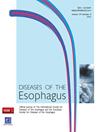Effectiveness and safety of stag beetle knife (SB knife) in management of Zenker’s diverticulum: a systematic review and meta-analysis
IF 2.3
3区 医学
Q3 GASTROENTEROLOGY & HEPATOLOGY
引用次数: 0
Abstract
Summary Stag Beetle Knife (SB Knife) is increasingly being utilized for Zenker’s Diverticulectomy (ZD). Our study assessed the effectiveness and safety of the SB Knife for the management of ZD. Ovid EBM reviews, Ovid Embase, Ovid Medline, ClinicalTrials.gov, Scopus, and Web of Science were searched to identify studies that utilized SB knife for ZD. Pooled proportions (PP) were calculated using the random-effects model. Heterogeneity was evaluated using I2 statistics. A total of 7 studies with 268 patients were included in the final analysis. Dysphagia and regurgitation were the most common clinical symptoms. The mean size of the ZD was 2.8 ± 0.7 cm and 28 (of 148) patients had undergone previous treatments. The PP of technical success was 98% (95% CI: 92.3–99.5; I20) with a mean procedure duration of 26.2 ± 8.3 minutes. The PP of clinical response at first follow-up and relapse after index procedure was 87.9% (95% CI: 81.6–92.3; I219) and 13.5% (95% CI: 9.6–18.6; I22), respectively. At final follow-up, the PP of clinical remission was 96.2% (95% CI: 91–98.4; I230.6) while the PP of procedure failure was 3.6% (95% CI: 1.6–8.1; I20). No severe adverse events (AEs) were noted while using the SB Knife. However, the PP of intraprocedural and postprocedural AEs was 13.2% (95% CI: 9.6–17.8; I20) and 9.3% (95% CI: 5.7–14.9; I2 < 20.9), respectively. SB Knife is highly safe and effective for Zenker’s Diverticulectomy with a failure rate of only 3.6%.矢车菊刀(SB刀)治疗禅克氏憩室的有效性和安全性:系统综述和荟萃分析
摘要 雄甲虫刀(SB 刀)越来越多地被用于 Zenker 胃憩室切除术(ZD)。我们的研究评估了 SB 刀治疗 ZD 的有效性和安全性。我们检索了 Ovid EBM reviews、Ovid Embase、Ovid Medline、ClinicalTrials.gov、Scopus 和 Web of Science,以确定使用 SB 刀治疗 ZD 的研究。采用随机效应模型计算汇总比例(PP)。使用I2统计量评估异质性。最终分析共纳入了 7 项研究,268 名患者。吞咽困难和反胃是最常见的临床症状。ZD的平均大小为2.8 ± 0.7厘米,有28名患者(共148名)曾接受过治疗。技术成功率为98%(95% CI:92.3-99.5;I20),平均手术时间为26.2±8.3分钟。首次随访时的临床反应PP为87.9%(95% CI:81.6-92.3;I219),指数手术后复发的PP为13.5%(95% CI:9.6-18.6;I22)。在最终随访中,临床缓解率为96.2%(95% CI:91-98.4;I230.6),而手术失败率为3.6%(95% CI:1.6-8.1;I20)。使用 SB 刀时未发现严重不良事件(AE)。然而,术中和术后AEs的PP分别为13.2% (95% CI: 9.6-17.8; I20) 和9.3% (95% CI: 5.7-14.9; I2 < 20.9)。SB刀对Zenker氏憩室切除术非常安全有效,失败率仅为3.6%。
本文章由计算机程序翻译,如有差异,请以英文原文为准。
求助全文
约1分钟内获得全文
求助全文
来源期刊

Diseases of the Esophagus
医学-胃肠肝病学
CiteScore
5.30
自引率
7.70%
发文量
568
审稿时长
6 months
期刊介绍:
Diseases of the Esophagus covers all aspects of the esophagus - etiology, investigation and diagnosis, and both medical and surgical treatment.
 求助内容:
求助内容: 应助结果提醒方式:
应助结果提醒方式:


